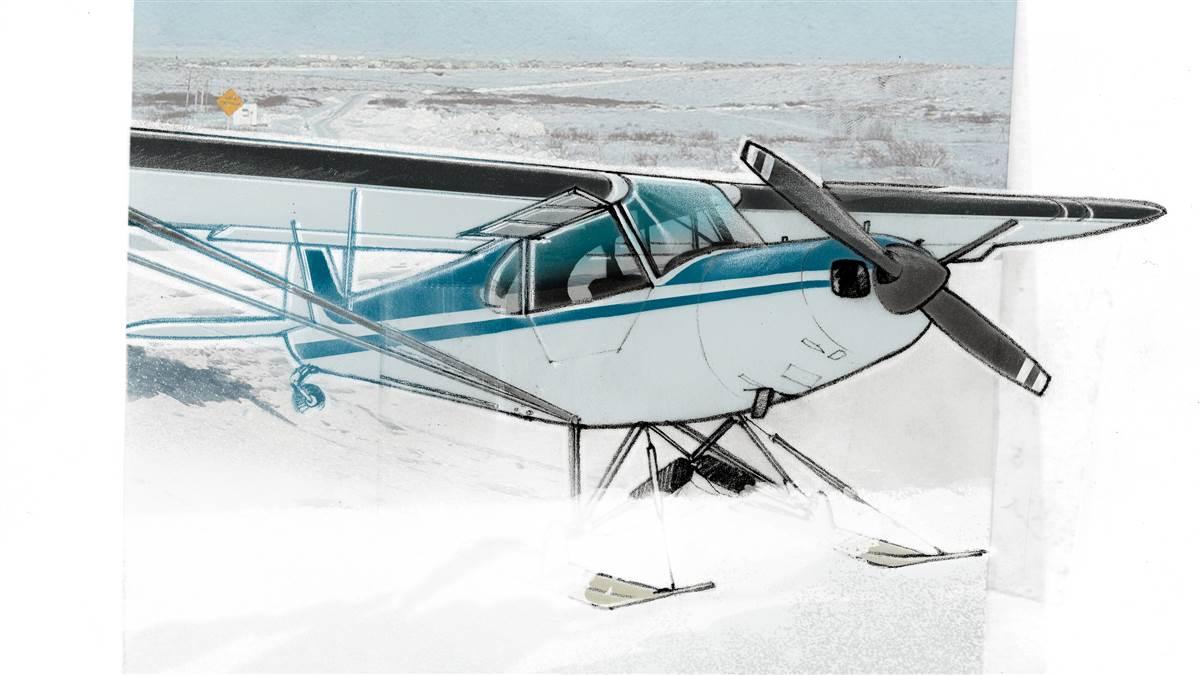Slip slidin' away
Super Cub versus ice pressure ridge

Hunters engage professional guides to assist them in taking trophy grizzlies in the spring. These hunts require extensive logistical support, and small aircraft are one of the principal means of getting the hunters, their guides, and supplies to and from the hunt locations.
I was new to flying on skis, with a few hours of instruction from an experienced guide/pilot and a few solo operations for practice. As a result, my activities were limited to moving equipment and supplies to and from the camps.
Flying out in my ski-equipped Piper Super Cub one day, I snaked my way through valleys and around various peaks. On a blue-sky day such as this one, the effect of the sun was dazzling. The reflected ambient light, even in the canyons, rendered the terrain nearly featureless for a lack of contrast and shadows.
Nearing the camp I was to visit, I examined an open area along a frozen stream adjacent to the camp that had served other pilots as a place to land. This involved making several low passes from different directions to get the benefit of varying light angles and shadows while looking for logs, rocks, brush, and black ice. Once that had been accomplished, the recommended practice was to make a very low pass along the intended landing line and gently touch the skis to the snow to leave a track, but not actually land—then go around and do it again, building up a good, visible track.
After a couple of passes, I landed. Abeam the camp, I shut down the airplane and unloaded the supplies I was carrying.
Since it was about midday, the camp was empty. After a quick snack, I did a quick walk around the airplane, climbed back in, started up, and did a magneto check while sliding along the track. Once I had negotiated the circle at the end, I departed.
About 10 miles north of town I checked in with the flight service station for weather and traffic advisories. The wind was out of the southwest at a few knots. The runways (one is paved, the other gravel) run more or less east/west and north/south, but both were clear of any usable amount of snow for landing. There was no reported traffic, so I stated my intention to land on the ice between the runways. This was the same area from which I had taken off—an area allowing at least 2,600 feet of ground run in any direction.
Setting up my final approach, I got the speed down initially to 50 miles an hour, with full flaps out and a low power setting, nearly idle. As I was close to touching down I noticed a pressure ridge in the ice ahead of me and nearly perpendicular to the line I was flying. Skis are mounted directly to the landing gear axles and have no shock absorbers, so I did not want to slam them into the pressure ridge. I added a couple hundred rpm for a few seconds, floated past the ridge, and then settled onto the ice into the wind.
The straight line I was on headed directly toward where we were keeping the airplanes, and the Alaska Army National Guard hangar. The hangar, located on a gravel area about 10 feet higher than the water/ice level, was rapidly growing larger as I slid along on the ice (skis do not have brakes). I could not initiate a go-around because of the hangar’s proximity and size, so I was pretty much just along for the ride.
Directly in my line of approach was a large, wind-packed snow drift sloping upward toward the building. I realized I was not going to stop before I got to it. I did a hasty shutdown of the aircraft in these last few seconds (mixture, magnetos, master, and fuel off) and opened the door panels on the right side. The airplane slid up the drift and came to a stop at the top—held in place by the ski tails digging into the drift. Looking out the left front window, I could see the ski tips extending over the drift’s edge by several inches. Below was air for about 15 feet to the rocks and gravel near the hangar’s foundation pilings. Ahead was a 10-foot gap between the top of the drift and the hangar, which was where I would have ended up if the airplane had gone any farther forward. I really should have gone around and set up along a different line. Crosswinds are not acceptable, however, since on ice the wind tends to have its way with you.
Leaving the airplane sitting there at the top of the drift, I went inside, got help to slide the airplane back down the drift to the ice to park it—and got correctly and properly chewed out for failing to go around when I still could have, back at the pressure ridge.
Author Mark M. Owen is a commercial pilot and flight instructor with more than 5,000 hours.
Digital Extra Hear this and other original “Never Again” stories as podcasts every month on iTunes and download audio files free.


